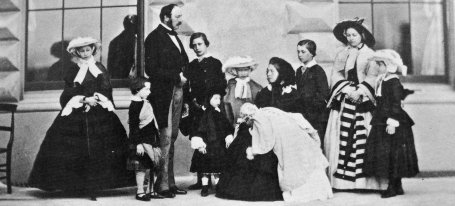A
particularly important category of genetic linkage has to do with the X and Y sex chromosomes. These not only carry the genes that determine male and
female traits but also those for some other characteristics as well. Genes that are
carried by either sex chromosome are said to be sex linked.
Men normally have an X and a Y combination of sex chromosomes, while women have two X's. Since only men inherit Y chromosomes, they are the only ones to inherit Y-linked traits. Men and women can get the X-linked ones since both inherit X chromosomes.
|
Sex cell inheritance patterns |
 |
X-linked recessive traits that are not related to feminine body characteristics
are primarily expressed in the observable characteristics, or phenotype
![]() ,
of men. This is due to the fact that men only have one X chromosome. Subsequently, genes on that
chromosome
not coding for gender are usually expressed in the male phenotype even if they are recessive
since there are no corresponding genes on the Y chromosome in most cases. In
women, a recessive allele on one X chromosome is often masked in their phenotype by a dominant normal
allele on the other. This explains why women are frequently carriers of
X-linked traits but more rarely have them expressed in their own phenotypes.
,
of men. This is due to the fact that men only have one X chromosome. Subsequently, genes on that
chromosome
not coding for gender are usually expressed in the male phenotype even if they are recessive
since there are no corresponding genes on the Y chromosome in most cases. In
women, a recessive allele on one X chromosome is often masked in their phenotype by a dominant normal
allele on the other. This explains why women are frequently carriers of
X-linked traits but more rarely have them expressed in their own phenotypes.
|
The "a" recessive allele |
 |
 |
The
"a" recessive allele |
|||
| male |
|
There
are about 1,098 human X-linked genes. Most of them code for
something other than female anatomical traits.
Many of the non-sex determining X-linked genes are responsible for abnormal conditions such as hemophilia
![]() ,
Duchenne muscular dystrophy
,
Duchenne muscular dystrophy
![]() ,
fragile-X syndrome
,
fragile-X syndrome
![]() , some high blood pressure,
congenital night blindness, G6PD deficiency, and the most common human genetic disorder,
red-green color blindness.
X-linked genes are also responsible for a common form of baldness referred
to as "male pattern baldness".
, some high blood pressure,
congenital night blindness, G6PD deficiency, and the most common human genetic disorder,
red-green color blindness.
X-linked genes are also responsible for a common form of baldness referred
to as "male pattern baldness".
If a woman is a carrier of an X-linked recessive
allele for a disorder and her mate does not have
it, their boys will have a 50% chance of inheriting
the disorder. None of their girls will have it, but
half of them are likely to be carriers.
dominant allele = A
recessive allele = a
If a man has an X-linked recessive disorder and his
mate does not carry the allele for it, all of their girls
will be carriers. None of their boys will inherit the
harmful allele. Only girls receive X chromosomes
from their fathers.
Queen Victoria of England was a carrier of the gene for hemophilia. She passed the harmful allele for this X-linked trait on to one of her four sons and at least two of her five daughters. Her son Leopold had the disease and died at age 30, while her daughters were only carriers. As a result of marrying into other European royal families, the princesses Alice and Beatrice spread hemophilia to Russia, Germany, and Spain. By the early 20th century, ten of Victoria's descendents had hemophilia. All of them were men, as expected.
|
|
|
Queen Victoria (1819-1901) with her husband and nine children in 1857 |
By comparison to the X chromosome, the much smaller Y chromosome has only about 26 genes and gene families. Most of the Y chromosome genes are involved with essential cell house-keeping activities (16 genes) and sperm production (9 gene families). Only one of the Y chromosome genes, the SRY gene, is responsible for male anatomical traits. When any of the 9 genes involved in sperm production are missing or defective the result is usually very low sperm counts and subsequent infertility. One in six American couples are infertile. It is now thought that about 1/3 of these couples is unable to have children as a consequence of the male mate not having the necessary sperm producing genes on his Y chromosome.
Because the Y chromosome only experiences recombination with the X chromosome at the ends (as a result of crossing-over), the Y chromosome essentially is reproduced via cloning from one generation to the next. This prevents mutant Y chromosome genes from being eliminated from male genetic lines except by inactivation or deletion. Subsequently, the Y chromosome now has few active genes and mostly contains genetic junk rather than genes.
Chimpanzees are our closest living relatives. They have been on a separate evolutionary path from humans for only 6-7 million years. Subsequently, we still share most of our genes. We differ by only 1-2% in terms of DNA sequences. However, the genes on the Y chromosome are a major exception. The DNA sequences on Y chromosomes of chimpanzees and humans differ by 30%. This indicates that Y chromosomes have been evolving at a much faster rate than the X and all other chromosomes.
NEWS: In the May 4, 2008 online issue of Nature, Ryohei Sekido and Robin Lowell-Badge reported that the SRY gene affects gender by activating and regulating a critical autosomal gene known as Sox9. If the Sox9 gene becomes active in an embryo with two X chromosomes, it causes male gonads to form instead of ovaries, and the individual develops into an anatomical male. If the Sox9 gene does not turn on in an embryo with XY sex chromosomes, the gonads develop into ovaries, and the individual becomes a female anatomically. The authors suggest that this could happen in up to 1 in 20,000 genetically male embryos (XY).




